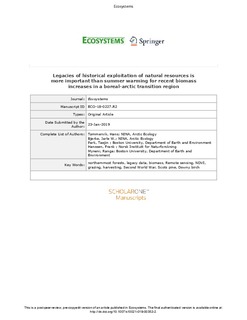| dc.contributor.author | Tømmervik, Hans | |
| dc.contributor.author | Bjerke, Jarle W. | |
| dc.contributor.author | Park, Taejin | |
| dc.contributor.author | Hanssen, Frank Ole | |
| dc.contributor.author | Myneni, Ranga B. | |
| dc.date.accessioned | 2019-07-09T08:09:40Z | |
| dc.date.available | 2019-07-09T08:09:40Z | |
| dc.date.issued | 2019 | |
| dc.identifier.issn | 1432-9840 | |
| dc.identifier.uri | http://hdl.handle.net/11250/2603838 | |
| dc.description.abstract | Eurasian forest cover at high northern latitudes (> 67 N) has increased in recent decades due to
stimulatory effects of global warming, but other factors may be important. The objective of this
study is to compare the importance of historical human exploitation and climate change. Periodic
information on forest and tundra resources along with human and domestic animal populations and
forest harvesting was collected from sources like official statistics and maps and compiled for joint
analysis. Our results show that the northernmost birch and Scots pine forests of the world often
presumed as pristine were repeatedly exploited by logging, agriculture and grazing in the last century.
In addition, repeated moth outbreaks have also had regulatory impacts on birch forest development.
Despite these disturbances, forested area quadrupled during the period, largely because of reduced
human activities in recent decades. Linear modelling confirms that the most important predictors
for the variation in Scots pine and birch biomass and area were logging, grazing and farming activity,
and not climatic changes. The dynamics in the forest cover over the last century seem to follow the
‘repeated human perturbation’ scenario. This study’s application of legacy data, and historical
and long-term data and evaluation of how the different drivers impacted some of the northernmost
forests are essential to understand whether the greening of the boreal and arctic regions is a
result of recent climate change or a recovery from earlier human impacts. | nb_NO |
| dc.language.iso | eng | nb_NO |
| dc.subject | northernmost forests | nb_NO |
| dc.subject | Scots pine | nb_NO |
| dc.subject | downy birch | nb_NO |
| dc.subject | historical data | nb_NO |
| dc.subject | biomass | nb_NO |
| dc.subject | NDVI | nb_NO |
| dc.subject | remote sensing | nb_NO |
| dc.subject | grazing | nb_NO |
| dc.subject | harvesting | nb_NO |
| dc.subject | Second World War | nb_NO |
| dc.title | Legacies of Historical Exploitation of Natural Resources Are More Important Than Summer Warming for Recent Biomass Increases in a Boreal–Arctic Transition Region | nb_NO |
| dc.type | Peer reviewed | nb_NO |
| dc.type | Journal article | |
| dc.rights.holder | © 2019 Springer Science+Business Media, LLC, part of Springer Nature | nb_NO |
| dc.subject.nsi | VDP::Matematikk og Naturvitenskap: 400::Zoologiske og botaniske fag: 480 | nb_NO |
| dc.source.journal | Ecosystems | nb_NO |
| dc.identifier.doi | 10.1007/s10021-019-00352-2 | |
| dc.identifier.cristin | 1686565 | |
